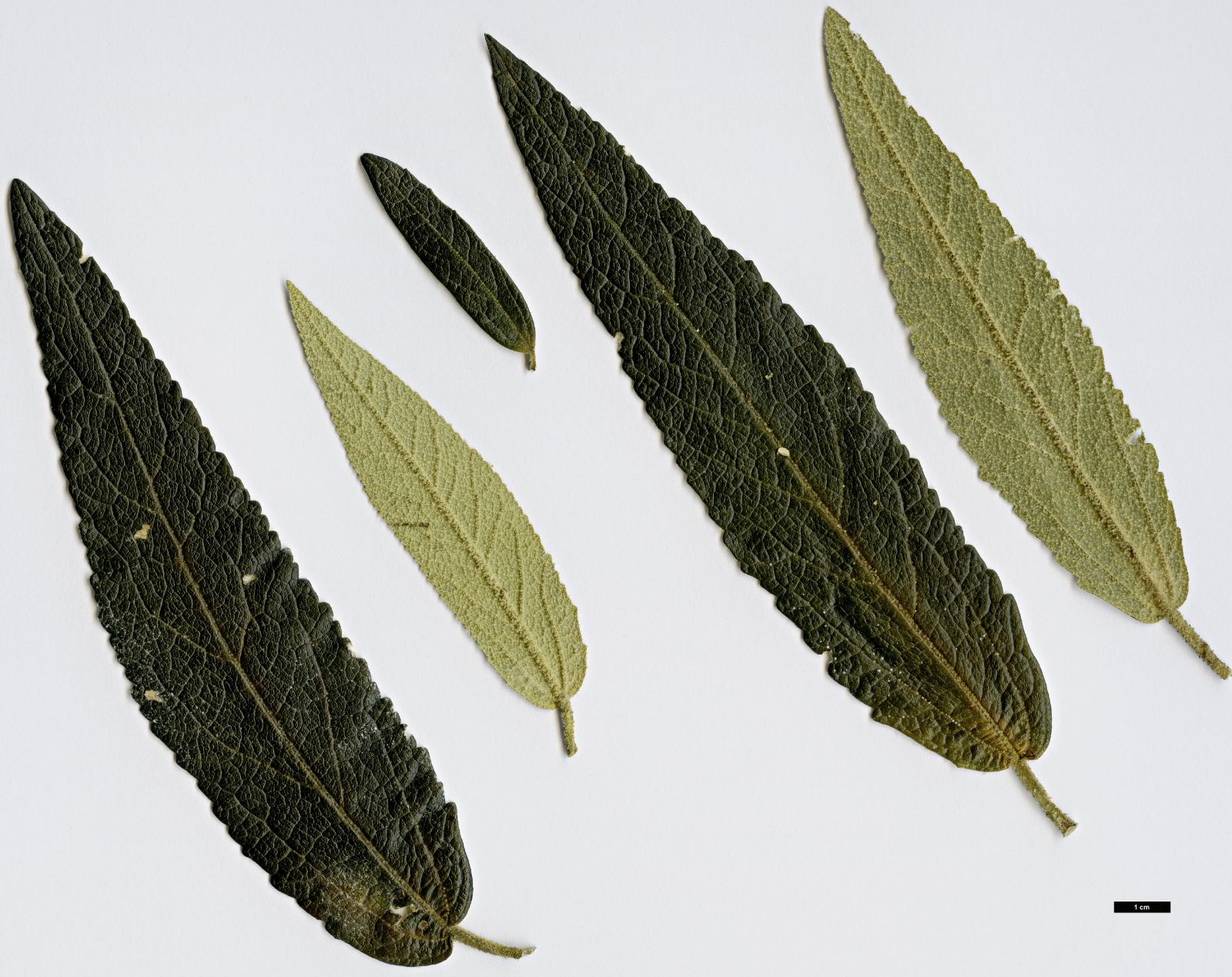Asterotrichion discolor
Sponsor
Kindly sponsored by
a member of the International Dendrology Society
Credits
Julian Sutton (2022)
Recommended citation
Sutton, J. (2022), 'Asterotrichion discolor' from the website Trees and Shrubs Online (treesandshrubsonline.
Genus
Common Names
- Currajong
- Tasmanian Currajong
- Tasmanian Hemp Bush
Synonyms
- Asterotrichion sidoides Klotzsch
- Plagianthus sidoides Hook.
Other taxa in genus
Medium to large evergreen shrub or small tree, 2–10 m. Bark fibrous. Branchlets, leaf undersides and inflorescences densely covered in stellate hairs which may be white or brown, stalked or sessile. Leaves alternate, petiolate, without stipules. Leaf blade lanceolate or ovate-lanceolate, 5–15 cm long; upper surface glabrous when mature, with impressed veins; lower surface densely stellate-hairy; base rounded; apex acute; margins bluntly serrate. Plant dioecious, rarely monoecious. Flowers unisexual, small, scented, in many-flowered terminal and axillary panicles, in autumn to winter. Male flowers with campanulate calyx, 3–4 mm long; petals creamy white, with a short tube bearing a nectariferous collar, and 5 lobes, ovate but assymetrical, spreading, 6–8 mm long; stamens 15–20, on filaments about as long as the column to which they are attached; carpels 2, reduced and sterile. Female flowers differ in their more tubular calyx ~4 mm long; petals only slightly exceeding the calyx, persistent; stamens small and sterile, sessile on top of the column; carpels 2, styles free, exserted from the staminal tube, hairy above, stigmatic surface dilated and blunt; ovary bilocular. Usually only one ovule matures, in which case the fruit is indehiscent, remaining within the persistent calyx. (Curtis & Morris 1975; Melville 1966; Rozefelds 2008; Jordan 2019).
Distribution Australia Tasmania (mainly E and SE)
Habitat Damp woods, along watercourses and in gullies, 0–700 m asl.
USDA Hardiness Zone 8-9
RHS Hardiness Rating H4
Conservation status Not evaluated (NE)
Little known outside Tasmania until recently, Asterotrichion discolor shows promise as a fast-growing, scented, autumn to winter-flowering evergreen shrub in milder parts of our area.
As a wild plant it grows in the understorey of eucalypt forest on the eastern side of the island, whose seasonal climate contrasts with that of the western rainforests. It was first described scientifically by Hooker (1834, 1835) as Sida discolor, from material collected by the early Tasmanian botanist Robert Lawrence. The specific epithet refers to the two-tone quality of the leaves, dark green and glabrous above but pale with dense stellate hairs beneath. It was known to indigenous people, the fibrous bark being used for binding (Hinsley 2022). The vernacular name Currajong in its alternative spelling Kurrajong is applied to several other Australian plants used this way, including Brachychiton spp..
Although an attractive evergreen, this is a plant grown primarily for its scented, creamy white flowers at a useful time of year. In both Tasmanian and British gardens it flowers from autumn well into winter, for a clear 3 months in the northern Tasmanian garden of Rosemary Verbeeten, who ranks it among her top 10 garden plants (Verbeeten 2020). It is a dioecious species, and the males are decidedly more attractive in flower. Their petals are much larger and more spreading, the inflorescences hang attractively rather than jut out, and Verbeeten (2020) – who also uses it as a cut flower – considers their fragrance stronger, ‘a nice fresh scent which is not too sweet’. Pollination seems not to have been studied scientifically, but the flowers produce nectar, and it is recommended for attracting honey bees (Wildseed Tasmania 2022).
This is a fast-growing shrub (Wildseed Tasmania 2022). A garden plant in a moist, sunny site with shelter from winds reached 3.5 m in height, with 1.5 m spread, in just 3 years (Verbeeten 2020). These are probably the ideal conditions, although seed supplier Wildseed Tasmania (2022) claims it as wind resistant, and tolerant of both wet and very dry soils, admittedly while recommending it for less ornamental uses such as windbreaks, screening and – even more prosaically – for planting on septic outflows. Both agree that tip pruning is possible.
There is a long but probably not continuous history of cultivation outside Tasmania, mainly in Britain with its cultural connections to Australia. Lawrence’s introduction from which Hooker described the species was as seed sent to Hooker in Glasgow, where it first flowered under glass at the Botanic Garden in autumn 1834 (Hooker 1835). He described it as a shrub ‘of no great beauty’ with ‘small and unobtrusive flowers’, which will have done nothing to encourage wider cultivation. It is unfortunate this this plant was a female (evident from his illustration in Curtis’s Botanical Magazine (Hooker 1835) although he described it as hermaphrodite, misinterpreting the reduced, sterile stamens). In the present century it has occasionally been grown in southern and western Britain, distributed from the early 2000s by Graham Hutchins’ County Park Nursery, Essex. There is a fine male specimen dating from 2009, about 4 m tall, in a sheltered but uncrowded position at RHS Garden Hyde Hall (C. Rogers pers. comm. 2022), and it is recorded (no wild provenance, again from 2009) in the car park at Logan Botanic Garden, SW Scotland (Royal Botanic Garden Edinburgh 2022). We have been unable to trace plants elsewhere in Europe, or in North America.
It can be propagated from seed, if available, or by cuttings (perhaps semi-ripe?) although it has been suggested that male plants root more easily (Understorey Network 2022).





